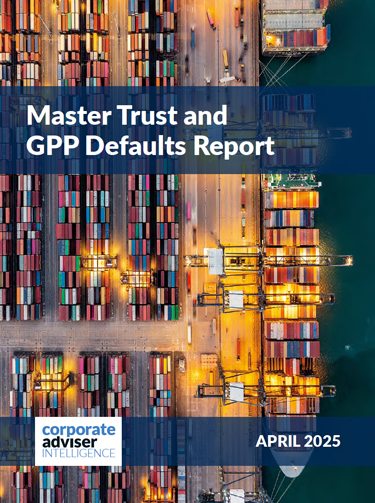It’s a happy 10th birthday for the Managed Core Retirement Pathway strategy, launched back in 2015 just as George Osborne was launching pension freedoms. For Jo Sharples, partner and chief investment officer DC solutions Aon, it has been a decade of success at the helm of the default.
Since Q2 2015 the fund has, for growth phase savers, delivered a return of more than 200 per cent, before charges are deducted, outperforming all other multi-employer providers’ principal defaults over that period, and beating the Corporate Adviser Pensions Average (CAPA) by more than 80 percentage points.
As an Aon lifer – her tenure with the firm started in 2000 as an actuarial associate straight after finishing her degree in mathematics at Durham – the role Sharples took was a significant one, forming a key element of the provider’s evolution into becoming a pension adviser competing with traditional players.
“We hit our 10-year anniversary at the end of May,” Sharples notes, “having come through Covid, political upheaval, gilt crises, and inflation shocks, and the strategy has held up really well.”
It is often said that investments within DC pension defaults are all pretty similar, and that benchmarking them promotes herding. But the performance outcome differentials between providers are huge. Some of that is down to basic calls on asset allocation. The higher equity-based strategies have inevitably beaten balanced managed approaches during the bullish equity markets of recent years – an outcome many had predicted. But there are even big performance differences between aggressive defaults.
Gilt call
Sharples points to some key calls. Aon’s removal of long-dated index-linked gilts ahead of the 2022 gilt crisis delivered significant outperformance for members, a move she credits to the inflation framework that had been put in place around the default. “We took out our long-dated index-linked gilts, which were expensive, at a time when we actually benefited from the fall in yields. And then we ran with that for about 12 months and hit the gilt crisis with Truss, having replaced them with a mix of equites, credit and short-dated gilts. So we saved members loads of money from that change.”
The retirement glidepath, too, was built with post-Freedom and Choice decumulation in mind, with Sharples proudly stating that “it de-risks over a decade and helps manage volatility — we’ve just run the numbers, and it’s working very well.”
Other drivers of performance have been geographical investments and currency fluctuations. “The US has been a huge boost for performance longer term, but also things like currency,” she adds.
Getting ESG right
Sharples is pragmatic when it comes to sustainability, and is critical of the way some strategies have been implemented across the industry. “Blunt exclusions get weird results,” she says. “The more thoughtful, rules-based strategies that genuinely integrate ESG considerations — they’re the ones that perform better.”
She says that Aon’s climate transition and sustainable development funds,
which are low-cost, rules-based equity strategies, have outperformed traditional benchmarks since launch. She says: “We’ve got two climate transition funds, trying to broadly follow the MSCI but to also incorporate sustainability. They’ve got specific objectives around carbon reductions, investing more in businesses, doing the right thing measured through the Sustainable Development Goals, more green energy, that sort of thing.”
Aon’s impact investments have faced more headwinds, she admits. “Impact hasn’t had an easy ride, but these are long-term themes,” she says. “We’re investing in things that need solving.”
Private markets caution
Sharples is cautious in her language around private markets, which will be introduced into both of Aon’s key defaults.
She says: “We think there’s huge potential for private markets to add value. But the caveat is that it’s such a big universe and not all private assets are created equal. And there’s no index to track. So the managers that you pick are super important. We’re moving towards more specialist managers, best of breed managers, rather than having generalists who will try and get to do everything. One of my worries for the industry is that people buy on price, not quality. And I think if people buy on price and get poor outcomes, because they want low charges they will end up with the worst deals. That’s terrible from an outcome perspective.”
Aon plans to launch an LTAF umbrella structure with two funds underneath, later this year, aligning with Mansion House reform ambitions. One sleeve will focus on growth-oriented assets like infrastructure and private equity, the other on retirement-aligned, more liquid income-producing assets. “But the plan is to start small and then gradually build it up over time.”
Mansion House support
With Aon a signatory to the Mansion House Accord does she feel like the ability to invest has been fettered?
“The 10 per cent [allocation to private markets] makes a huge amount of sense because we think private assets are good and will add value. And 10 per cent makes for meaningful allocations. I think the timescales are realistic as well. The 5 per cent allocation to UK is probably a little bit more challenging because there is concern about whether there are enough opportunities to go around and what they look like. So can the Government be more joined up to make sure they are there? Because what we don’t want to be doing is buying existing UK opportunities at a high price from a Canadian pension scheme.
“But that said, we’ve spoken to lots of managers, probably over 50 in the last two to three years, and I’ve seen some really good specialist UK funds.”
So what needs to be done to make this work for UK savers?
“One of the challenges at the moment is fees are a barrier. And that is partly down to how they get disclosed, particularly when you’re using third party funds. There isn’t a level playing field between listed and unlisted. So if you look at a listed company, there’s a cost of running that company and that comes through in the company accounts. It’s in the share price. When you then look at unlisted company that’s in the management charge. You need to address this so people don’t just write it off because it’s too expensive,” she says.
She thinks performance fees are well-aligned with member outcomes and says hurdle rates vary from 8 to 10 per cent for ‘high octane’ assets, and a bit lower for lower risk investments. She hasn’t seen a performance fee higher than 20 per cent however.
So if private markets have such potential, why wouldn’t we see even bigger allocations? Could Aon go to 30 per cent?
“Well possibly, but we have got to get it off the ground, make sure the liquidity works, make sure we can get people in and out, get contributions in, and make sure there’s enough opportunities. 10 per cent is a good place to start – but you could probably go to 30 per cent, maybe 40 per cent if you are cash flow positive. So long as you have more money going in than coming out, you will be fine. But you do need to keep your eye on cash flow. I don’t think this will happen at the moment, but if the amount coming out starts to exceed that coming in, your allocations can explode in size. Even a 10 per cent allocation can grow quite big quite quickly.”
Sharples sees her scheme as being in a good place here. “We’re lucky,” she says. “Our master trust is still in a growth phase – younger members, larger pots, more contributions than outflows.”
At-retirement exits?
She reports ‘substantial increases’ in the proportion of members reaching retirement and opting to stay in the master trust. “It’s doubled over the last year, partly down to ease, but also expectation management. A lot of people have come from an occupational scheme run by their employer, and at retirement you had to go somewhere else. Now they’re in a master trust and they can stay.”
CDC? Probably
Aon has been vocal in its support of collective DC. “We were there at the beginning,” she says, referencing Aon’s involvement since 2013. But timelines are now stretching toward 2027 at the soonest. for full multi-employer, whole-of-life CDC vehicles, assuming regulations are finalised. Reading the runes of her response on CDC it seems likely Aon will launch something in this field. “It’s close to our heart and we’re looking at all the options,” she says.
Passion for literature
Away from the world of DC pensions, Sharples enjoys gardening, writing historical fiction (unpublished – “Probably set around 200 years ago, when there were horses. I don’t even let my husband read them”), and spending time with her children.
She now marks 25 years in the industry, but it was a career that nearly didn’t happen. “I remember in my first week all these headlines about pension scheme shutting. And I remember thinking I should have taken another job offer. But DC has been a great opportunity.
“DC is the future. I like making a difference — and I can drive past a business and think, we look after their pension scheme. They’ll never know, but that’s a good feeling.”





